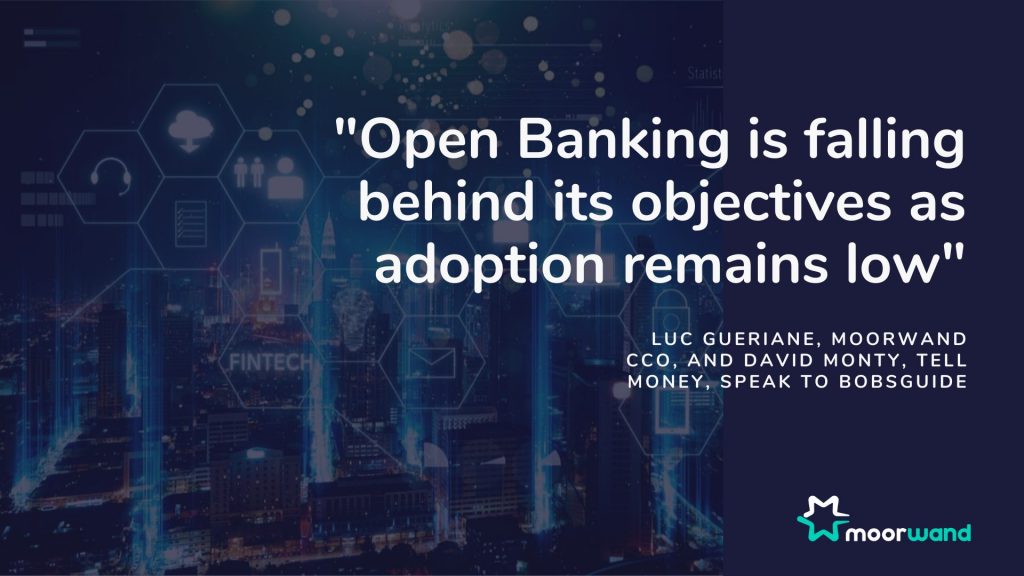
Open Banking is falling behind its objectives as adoption remains low.
By Leana Reeves at Bobsguide
Despite having registered over two million users in the UK, Open Banking is still failing to meet its objectives of creating a more competitive retail banking landscape.
“Everything that it’s looking to achieve in terms of improving competition and transparency amongst the incumbent banks, and diluting a little bit the reliance on the banks and allowing easier access to new entrants – it can only be achievable if it becomes sort of mainstream,” says Luc Gueriane, chief commercial officer at Moorwand.
“It’s way behind target. The usage is so incredibly low, that even though we’ve got a huge regulatory burden we’ve got hardly any benefits.”
Open Banking in the UK was implemented as part of the Open Banking Implementation Entity (OBIE), established by the CMA in 2016. It is also enclosed in the Second Payment Services Directive (PSD2) – a European legislation created in 2018 to offer third party providers the access of bank account information of consumers and payments requests to provide innovative services.
David Monty, director at Tell.Money, says Open Banking requires everyone in the ecosystem to embrace it.
“If I’m a digital challenger bank, I can’t see any customers wanting to use Open Banking for my service. That fundamentally sums up the problem.”
Monty also believes current users aren’t adopting Open Banking for the right purpose as individuals are now using it to connect their bank accounts into their own apps.
Fintechs, however, are expected to widen the adoption of Open Banking.
“It’s taking time to propagate across to the market for the infrastructure to be there, but the providers are sort of gradually coming into the market, providing some solutions to make it more accessible. Different Fintechs can leverage the tools that are now available to them and then bring to the market some interesting business cases that would accelerate the uptake,” says Gueriane.
To accelerate the uptake, Monty says awareness and attitude will need to be changed as the industry embraces new payment services.
One of the biggest barriers to Open Banking remains the additional cost of the service.
“Where the intention was to democratise the service by making it more open and potentially reducing the cost, an additional cost is being layered by people building it,” explains Monty. “there are large organisations that provide decent standards, but they are under pressure to be commercialised.”
Markets, organisations, and businesses need to understand how they can create new money flows that benefit both consumers and businesses, add Monty.
“We need to encourage the industry to see Open Banking as a positive opportunity, even if the immediate benefits aren’t clear.”
The Payments Association
St Clement’s House
27 Clements Lane
London EC4N 7AE
© Copyright 2024 The Payments Association. All Rights Reserved. The Payments Association is the trading name of Emerging Payments Ventures Limited.
Emerging Ventures Limited t/a The Payments Association; Registered in England and Wales, Company Number 06672728; VAT no. 938829859; Registered office address St. Clement’s House, 27 Clements Lane, London, England, EC4N 7AE.







Log in to access complimentary passes or discounts and access exclusive content as part of your membership. An auto-login link will be sent directly to your email.
We use an auto-login link to ensure optimum security for your members hub. Simply enter your professional work e-mail address into the input area and you’ll receive a link to directly access your account.
Instead of using passwords, we e-mail you a link to log in to the site. This allows us to automatically verify you and apply member benefits based on your e-mail domain name.
Please click the button below which relates to the issue you’re having.
Sometimes our e-mails end up in spam. Make sure to check your spam folder for e-mails from The Payments Association
Most modern e-mail clients now separate e-mails into different tabs. For example, Outlook has an “Other” tab, and Gmail has tabs for different types of e-mails, such as promotional.
For security reasons the link will expire after 60 minutes. Try submitting the login form again and wait a few seconds for the e-mail to arrive.
The link will only work one time – once it’s been clicked, the link won’t log you in again. Instead, you’ll need to go back to the login screen and generate a new link.
Make sure you’re clicking the link on the most recent e-mail that’s been sent to you. We recommend deleting the e-mail once you’ve clicked the link.
Some security systems will automatically click on links in e-mails to check for phishing, malware, viruses and other malicious threats. If these have been clicked, it won’t work when you try to click on the link.
For security reasons, e-mail address changes can only be complete by your Member Engagement Manager. Please contact the team directly for further help.